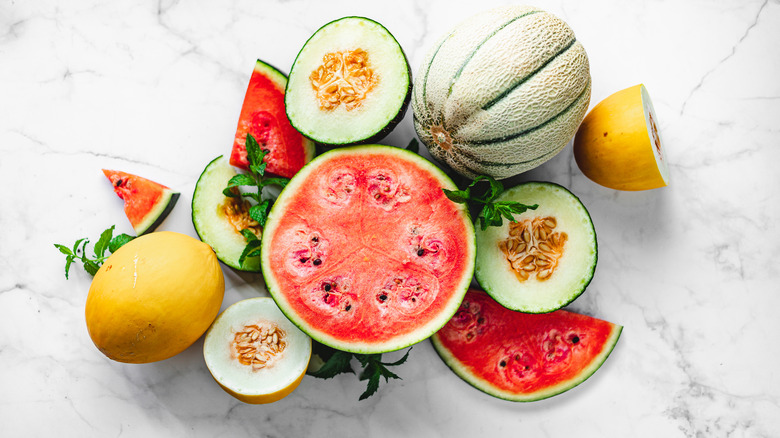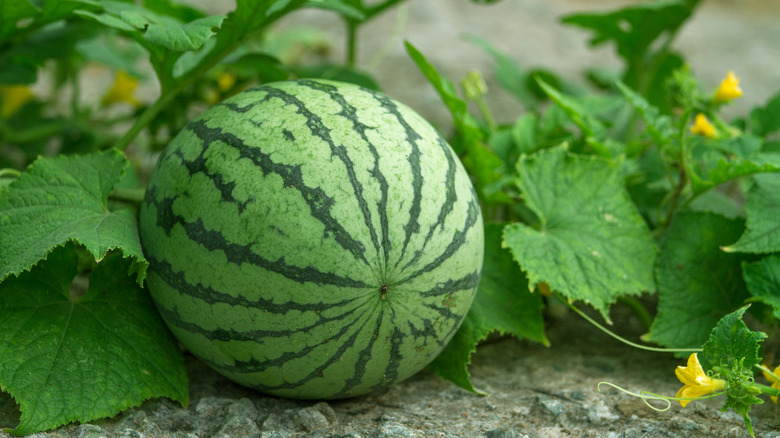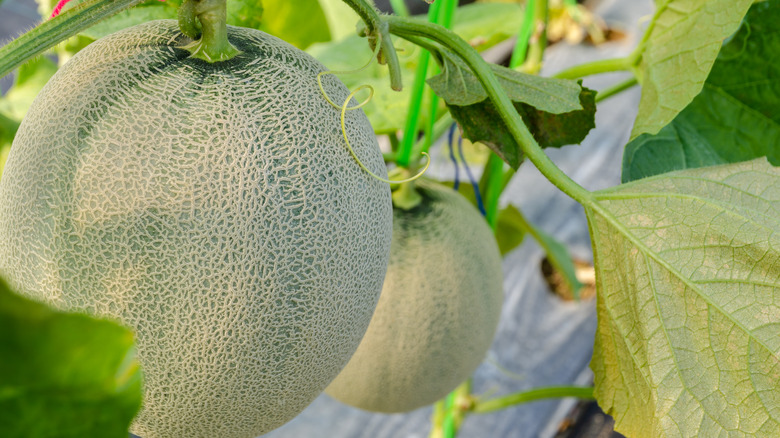Why You Should Never Cut Into An Unwashed Melon
Summer in a rounded rind — that's the best way to describe the juicy deliciousness of Mother Nature's melon creations. Warm weather brings forth a diverse array of melon varieties, including honeydews, cantaloupes, casaba, galia, canary, watermelons, crenshaws, charentais, and the charmingly-named sugar babies and "moon and stars." Regardless of its melon moniker or the delightful flavor variations it offers, one undeniable fact remains consistent within the melon branch of the gourd family: All melons have tough outer skins or rinds that serve as protective layers for the tender and flavorful inner flesh. Though admirable for their tough resilience, it's those rinds that can present a threat to human health, according to Michigan State University. Fortunately, all it takes to eliminate the issue is some water and a few minutes of your time.
Washing a melon before slicing is crucial for protecting the inner fruit from contamination. Since most melons grow either on or near the ground, they're more exposed than other fruits to contaminants from the soil, water, fertilizers, and field animals. The outer rinds can also be exposed to bacteria during harvesting, transporting, or extra handling as the heavy fruits get passed from hand to hand. When an unwashed melon is sliced with a knife, it's a direct invitation for all the germs and bacteria residing on the rind to make their way right into the tender flesh of the fruit, and consequently, into your mouth. Multiple slices into the same melon continue spreading that unwanted danger.
Rinse and scrub before slicing a melon
It's good practice to wash any kind of fruit or vegetable before consumption, but that goes double for melons. First of all, they have larger surface areas on which germy parasites, mold, and bacteria can reside. Because of their extra girth and weight, melons are more likely to be individually handled rather than packaged or transferred in bulk. They're also one of the least likely fruits to be cooked, which could eliminate harmful bacteria under the right heating conditions, as reported by the Food Standards Agency. Melons typically get eaten raw, so washing before slicing is crucial.
Cleaning a melon rind or skin is a relatively easy process. Just place the melon under a stream of cool water and rinse thoroughly. Use a food-appropriate scrub brush to remove any contaminants that may be clinging to the rind, taking special care to cleanse areas that appear bruised, scratched, or damaged in any way. The blemishes can provide extra pathways for bacteria to hide or mold and mildew to form. If you feel safer doing so, consider rinsing the melons in an outdoor water spigot rather than your kitchen sink. Avoid using soaps or bleaches, and pat thoroughly with a clean cloth. Be sure to wash your hands as well.
Two melons with extra exposure risks
The tantalizing flavors and colors nestled inside various melon rinds are like exotic cooling elixirs on hot summer days. But the varying characteristics from melon to melon also include the exterior features, some of which are more prone to absorbing pollutants.
Look closely at the skin of a cantaloupe, and you'll notice an intricate netted texture that's fascinating as a feat of nature. However, those artistic lacy patterns are the perfect cubbyholes for trapping bacteria and have been traced to multiple food poisoning outbreaks, per the U.S. Food and Drug Administration (FDA). They're also harder to clean. That's when the bristles of a vegetable brush come in handy, along with some extra scouring time. If possible, avoid buying any cantaloupe with obvious damage or mold.
Watermelons also need more thorough cleaning than other melons, but not because of the texture of the rinds. Instead, they have a considerably larger platform for attracting contaminants, and even more notable is the position in which they grow. Watermelons often mature on vines that lie directly on the ground. And you guessed it: That's where most of the insects and other potentially harmful elements reside.
Another good time to thoroughly scrub that watermelon is if you decide to eat the rind. It's completely edible, and there are a lot of reasons to indulge. The benefits range from its rich fiber content to its potential to lower blood pressure, enhance libido, and improve exercise performance.



